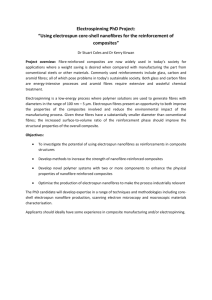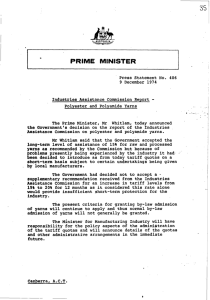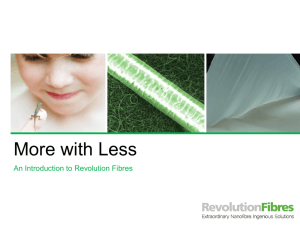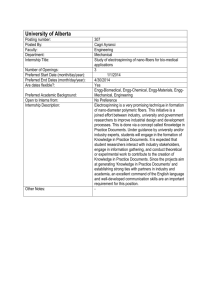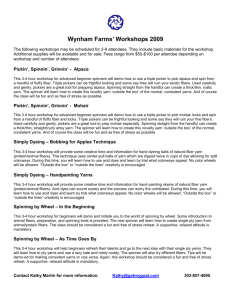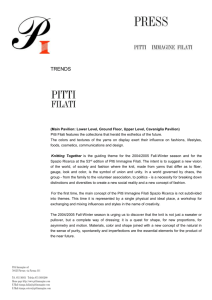Insertion of Electrospun Nanofibres into the Inner Structure of Textiles Audrone Ragaišienė,
advertisement
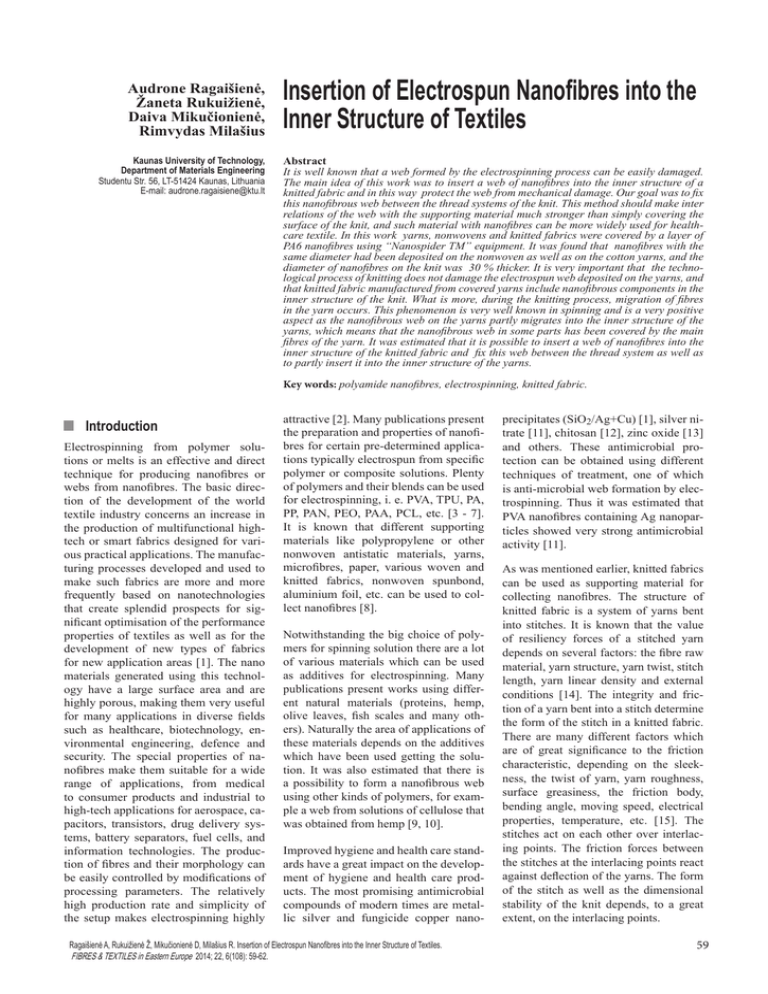
Audrone Ragaišienė, Žaneta Rukuižienė, Daiva Mikučionienė, Rimvydas Milašius Kaunas University of Technology, Department of Materials Engineering Studentu Str. 56, LT-51424 Kaunas, Lithuania E-mail: audrone.ragaisiene@ktu.lt Insertion of Electrospun Nanofibres into the Inner Structure of Textiles Abstract It is well known that a web formed by the electrospinning process can be easily damaged. The main idea of this work was to insert a web of nanofibres into the inner structure of a knitted fabric and in this way protect the web from mechanical damage. Our goal was to fix this nanofibrous web between the thread systems of the knit. This method should make inter relations of the web with the supporting material much stronger than simply covering the surface of the knit, and such material with nanofibres can be more widely used for healthcare textile. In this work yarns, nonwovens and knitted fabrics were covered by a layer of PA6 nanofibres using “Nanospider TM” equipment. It was found that nanofibres with the same diameter had been deposited on the nonwoven as well as on the cotton yarns, and the diameter of nanofibres on the knit was 30 % thicker. It is very important that the technological process of knitting does not damage the electrospun web deposited on the yarns, and that knitted fabric manufactured from covered yarns include nanofibrous components in the inner structure of the knit. What is more, during the knitting process, migration of fibres in the yarn occurs. This phenomenon is very well known in spinning and is a very positive aspect as the nanofibrous web on the yarns partly migrates into the inner structure of the yarns, which means that the nanofibrous web in some parts has been covered by the main fibres of the yarn. It was estimated that it is possible to insert a web of nanofibres into the inner structure of the knitted fabric and fix this web between the thread system as well as to partly insert it into the inner structure of the yarns. Key words: polyamide nanofibres, electrospinning, knitted fabric. n Introduction Electrospinning from polymer solutions or melts is an effective and direct technique for producing nanofibres or webs from nanofibres. The basic direction of the development of the world textile industry concerns an increase in the production of multifunctional hightech or smart fabrics designed for various practical applications. The manufacturing processes developed and used to make such fabrics are more and more frequently based on nanotechnologies that create splendid prospects for significant optimisation of the performance properties of textiles as well as for the development of new types of fabrics for new application areas [1]. The nano materials generated using this technology have a large surface area and are highly porous, making them very useful for many applications in diverse fields such as healthcare, biotechnology, environmental engineering, defence and security. The special properties of nanofibres make them suitable for a wide range of applications, from medical to consumer products and industrial to high-tech applications for aerospace, capacitors, transistors, drug delivery systems, battery separators, fuel cells, and information technologies. The production of fibres and their morphology can be easily controlled by modifications of processing parameters. The relatively high production rate and simplicity of the setup makes electrospinning highly attractive [2]. Many publications present the preparation and properties of nanofibres for certain pre-determined applications typically electrospun from specific polymer or composite solutions. Plenty of polymers and their blends can be used for electrospinning, i. e. PVA, TPU, PA, PP, PAN, PEO, PAA, PCL, etc. [3 - 7]. It is known that different supporting materials like polypropylene or other nonwoven antistatic materials, yarns, microfibres, paper, various woven and knitted fabrics, nonwoven spunbond, aluminium foil, etc. can be used to collect nanofibres [8]. Notwithstanding the big choice of polymers for spinning solution there are a lot of various materials which can be used as additives for electrospinning. Many publications present works using different natural materials (proteins, hemp, olive leaves, fish scales and many others). Naturally the area of applications of these materials depends on the additives which have been used getting the solution. It was also estimated that there is a possibility to form a nanofibrous web using other kinds of polymers, for example a web from solutions of cellulose that was obtained from hemp [9, 10]. Improved hygiene and health care standards have a great impact on the development of hygiene and health care products. The most promising antimicrobial compounds of modern times are metallic silver and fungicide copper nano- Ragaišienė A, Rukuižienė Ž, Mikučionienė D, Milašius R. Insertion of Electrospun Nanofibres into the Inner Structure of Textiles. FIBRES & TEXTILES in Eastern Europe 2014; 22, 6(108): 59-62. precipitates (SiO2/Ag+Cu) [1], silver nitrate [11], chitosan [12], zinc oxide [13] and others. These antimicrobial protection can be obtained using different techniques of treatment, one of which is anti-microbial web formation by electrospinning. Thus it was estimated that PVA nanofibres containing Ag nanoparticles showed very strong antimicrobial activity [11]. As was mentioned earlier, knitted fabrics can be used as supporting material for collecting nanofibres. The structure of knitted fabric is a system of yarns bent into stitches. It is known that the value of resiliency forces of a stitched yarn depends on several factors: the fibre raw material, yarn structure, yarn twist, stitch length, yarn linear density and external conditions [14]. The integrity and friction of a yarn bent into a stitch determine the form of the stitch in a knitted fabric. There are many different factors which are of great significance to the friction characteristic, depending on the sleekness, the twist of yarn, yarn roughness, surface greasiness, the friction body, bending angle, moving speed, electrical properties, temperature, etc. [15]. The stitches act on each other over interlacing points. The friction forces between the stitches at the interlacing points react against deflection of the yarns. The form of the stitch as well as the dimensional stability of the knit depends, to a great extent, on the interlacing points. 59 way the web of nanofibres would be more protected against mechanical damage. n Materials and test methods A web from PA6 nanofibres was created using “NanospiderTM” equipment (Elmarco, Czech Republic) with a plain cylindrical rotational electrode (see Figure 1). Figure 1. Electrospinning process of “NanospiderTM” equipment [17]. 1 cm 40 cm Nonwoven spunbond Cotton yarn Figure 2. Scheme of cotton yarn spacing on the surface of nonwoven for nanofibrous web formation. Some researchers undertook the mixing of the electrospinning and electrospraying processes as tools for the production of nonwoven nanocomposite fabrics from a polymer material with nanoparticles deposited on the fibre surface. The materials are not damaged during the spraying and spinning processes [6]. While analysing literature sources, it was noticed that it is difficult to fix a web of nanofibres on a supporting material [16]. A polymer nanofibre is very weak and any direct touch on the mat surface during usage can damage a web from nanofibres, which can be lost from the surface of the supporting material, making the usage of an electrospun nanofibrous web for healthcare wearable textiles very complicated. We suppose that knitting from yarns covered by an electrospun web could make the web more resistant to various mechanical damage because of the knitted structure, especially the interlacing points. The aim of the work presented was to insert a web of nanofibres into the inner structure of knitted fabric and to fix this web between the yarn system. In such a 60 PA6 solution of 15 wt.% concentration was prepared using as solvent of 8% formic acid. The speed of the supporting material movement was 0.002 m/s, the distance between the electrodes - 0.13 m, the applied voltage - 70 kV, the temperature of the electrospinning environment 20 ± 2 °C, and the air humidity - 48 ± 2%. The polymer was chosen not at random, but taking into account the possibility of its application for health care textiles. PA6 polymer is very well suited for manufacturing an electrospun web with antibacterial particles, silver etc. This polymer is friendly for human organisms and is widely used for medical textiles. Moreover from this polymer it is possible to manufacture very fine nanofibres down to 50 nm, which is very important for the nanofibre web used for the transportation of active particles on supporting material. It is well known that formic acid is a hazardous solvent, but on the other hand it is one of the best solvents for obtaining thin PA nanofibres by electrospinning, especially using “NanospiderTM” equipment [17]. An 8% concentration of formic acid is enough for a successful electrospinning process. The solvent evaporates during the electrospinning process, but of course special attention should be maintained for good ventilation. The web was formed on different types of supporting material: n polypropylene nonwoven (with 21.5 g/m2 surface mass), ncotton yarns (25 tex × 2 linear density), nknitted fabric made from 25 tex × 2 cotton yarns (single jersey structure). The polypropylene nonwoven was used only as a supporting material for comparison of the various nanofibre structure webs obtained: Do the yarns or knit influence the eloctrospinning process? A web of electrospun nanofibres was formed not only on a flat textile, like nonwoven or woven/ knitted fabrics, but also on yarns. Yarns are not a typical supporting material for nanofibre formation. Yarns cov- ered by nanofibres were used for knitting in order to study the possibility of inserting nanofibres into the inner structure of the knit. The principle scheme of nanofibrous formation on yarns is presented in Figure 2. The yarns were spaced every 1 cm across the whole width of the polypropylene nonwoven (40 cm width) and were covered by nonofibrous web together with the nonwoven. After electrospinning, the yarns were wrapped by hand withand, the nonwoven wound on a bobbin, and further used for knitting. The structure of the electrospun nanofibre webs received was analysed by Scanning Electron Microscope (SEM) Quanta 200 (FEI, Netherlands). The diameter of nanofibers was measured from SEM images by the LUCIA Image 5.0 programme (Laboratory Imaging, Czech Republic), with an accuracy of ± 0.01 nm. All nanofibres (single and stick) were measured from every SEM image. At least 3 SEM images for each type of nanofibrous web were used. After the electrospinning process, cotton yarns coated by an electrospun nanofibrous web were used for knitting using a flat double bed weft knitting machine (10E gauge), forming a rib 1×1 structure. The knitting speed was 0.5 m/s. The same structure of knit also was knitted fromundertaken for cotton yarns not coated. These knits after knitting were covered by an electrospun nanofibrous web, which means that two variants of knits with nanofibres were manufactured: one knitted from yarns covered by electrospun nanofibres and the other one with a nanofibrous layer deposited on the surface of the knit. n Results and discussions SEM images of the electrospun webs on the different types of materials are presented in Figure 3. It was found that the diameter of electrospun nanofibres depends on the type of supporting material. Average values of the nanofibre diameter were obtained: 58.0 nm of fibres deposited on the polypropylene nonwoven, 58.4 nm on the cotton yarns and 75.1 nm on the knitted fabric. Thicker nanofibres were formed on the knitted fabric due to the influence of the cotton knit on the electric field between the electrodes, while cotton yarns spaced 1 cm from each other do not have a negative effect on the electrostatic field, with the difference in the average diameter being only FIBRES & TEXTILES in Eastern Europe 2014, Vol. 22, 6(108) a) b) c) Figure 3. SEM images of electrospun webs: a) on the nonwoven, b) on the cotton yarn, c) on the knit. 0.4 nm, which is in the limits of error. A histogram of distributions of the nanofibre diameter is presented in Figure 4. As is seen in Figure 4, all the distributions are very similar, but the highest frequency of the nanofibre diameter on the knit (44.4% of all nanofibres) is in the range of 40 - 70 nm, while on the nonwoven and yarns it is in the range of 30 - 60 nm (57.4 % and 53.1 % respectively), which means that the distributions of the nanofibre diameter show that cotton yarns do not influence the electrospinning process: the same structure of the web was obtained on the single nonwoven and the same on the nonwoven with yarns. The main idea of this work was to obtain a structure of textiles with an electrospun nonofibrous web which will be more resistant to mechanical damage. To achieve this, the yarns covered by the electrospun web were knitted into the knit on a flat knitting machine. Knitting was chosen instead of weaving because less quantity of yarns is necessary for knitting and the yarns are exposed to less mechanical frictions during the knitting process than in the process of weaving. Furthermore stitches in the knitted fabric have interlacing points between each other, in which the electrospun web can be protected by the main fibres of the yarns (see Figure 5, page 62). In the knitting process, yarns are affected by friction with various parts of the knitting machine: thread guides, guide bars, hooks of the needles, etc., which can damage the electrospun nanofibrous web, which can even be lost. Therefore it was very important to check of the nanofibrous web remaining in the knitted fabric. An SEM image of the knit made of yarns covered by a nanofibrous web is presented in Figure 6 (see page 62). As is seen in Figure 6, the nanofibrous web remained on cotton fibres in the yarn after the knitting process. Of course, we cannot state that some parts of the nanofibrous web were lost, but it is evident that at least some parts of the electrospun nanofibres still exist in the yarn. Furthermore the electrospun PA6 web is covered in some places by cotton fibres (it is easily seen in the central part of Figure 6). 25 Frequency, % freq uency, % 20 15 10 5 0 0-10 10- 20- 30- 40- 5020 30 40 50 60 60- 70- 80- 90- 100- 110- 120- 130- 140- 150- 160- 170- 190- 200- 21070 80 90 100 110 120 130 140 150 160 170 180 200 210 220 d, nm mm d, Figure 4. Distributions of nanofibre diameter: FIBRES & TEXTILES in Eastern Europe 2014, Vol. 22, 6(108) - on the nonwoven, - on the cotton yarn, - on the knit. 61 Figure 5. Interaction of stitches in a weft knit (IP – interlacing points). Fibres of cotton yarn Nanofibres Figure 6. SEM image of a knit from yarns covered by a nanofibrous web. In spinning, such a phenomenon as the migration of fibres in the structure of yarn is very well known. Our investigations demonstrate that such a phenomenon also partly occurs during the knitting process and that it positively affects the structure – the nanofibrous web migrates partly into the structure of the yarn. It means that such a structure of textiles with nanofibres is much more suitable for healthcare wearable textiles than the same kind of textiles with a surface covered by an electrospun nanofibrous web. In this stage of our investigations we did not analyse the percentage quantity of nanofibres, which was lost at the knitting process. It is very important and will be made in the further investigations. Also, the functional and comfort properties as well as abrasion resistance of the knits made from yarns coated with nanofibres will be the object of the next step of our investigations. nConclusions n Cotton yarns spaced at 1 cm distance on polypropylene nonwoven do not 62 influence the electrospinning process. The nanofibrous web is formed with the same average diameter of nanofibres and with a very similar distribution of the diameter of the fibres to that of nonwoven without the yarns, while on cotton knitted fabric the web is formed from thicker nanofibres because of the influence of the knit on the electric field. n After the knitting process, a knit made from cotton yarns covered by an electrospun PA6 nanofibrous web still has PA6 nanofibres in the structure of the yarns. nIn a knit made from yarns covered by a nanofibrous web, some parts of the web are protected against mechanical damage by the interlacing points between stitches in the knit as well as in some parts by the elementary cotton fibres. The migration of fibres in the cotton yarn which occurred at the time of the knitting process positively affects the structure of cotton yarns covered by electrospun PA6 nanofibres. Some parts of the web migrate into the inner layers of cotton yarns and become partly protected by cotton fibres. nAn electrospun web in a knit made from yarns covered by nanofibres is more resistant against mechanical damage than an nanofibrous web on the knit, which can be more suitable for healthcare wearable textiles. Acknowledgements The authors would like to acknowledge the contribution of 7FP 2BFUNTEX and COST Action MP1206. References 1. Brzeziński S, et al. Antibacterial and Fungicidal Coating of Textile-polymeric Materials Filled with Bioactive Nano-and Submicro-particles. Fibres & Textiles in Eastern Europe 2012; 20, 1, 90: 70-77. 2. Kumar PR, et al. Nanofibers: effective generation by electrospinning and their applications. Journal of Nanoscience and Nanotechnology 2012; 1, 12, 1: 1-25. 3. Malašauskiene J, Milašius R. Investigation and Estimation of Structure of Web from Electrospun Nanofibres. Journal of Nanomaterials 2013; DOI:10.1155/2013/416961. 4. Šukytė J, et al. Formation of Poly(Vinyl Alcohol)/Cationic Starch Blend Nanofibres via the Electrospinning Technique: The Influence of Different Factors. Fi- bres & Textiles in Eastern Europe 2012; 20, 3, 92: 16-20. 5. Banuškevičiūtė A, et. al. Formation of Thermoplastic Polyurethane (TPU) Nano/Micro Fibers by Electrospinning Process Using Electrode with Tines. Materials science = Medžiagotyra 2011; 17, 3: 287-292. 6. Jaworek A, et al. Electrospinning and electrospraying techniques for nanocomposite non-woven fabric production. Fibers & Textiles in Eastern Europe 2009; 17, 4: 77-81. 7. Theron SA, Zussman E, Yarin AL. Experimental investigation of the governing parameters in the electrospinning of polymer solutions. Polymer 2004; 45, 6: 2017-2030. 8. Yalcinkaya B, Cengiz Callioglu F. The Effect Of Supporting Material Type On The Nanofiber Morphology. Proceedings of Nanocon EU 2011; September 21-23, Brno, Czech Republic, 1-5. 9. Sutka A, et. al. Nanofibre Electrospinning Poly(vinyl alcohol) and Cellulose Composite Mats Obtained by Use of a Cylindrical Electrode. Advances in Materials Science and Engineering 2013; DOI: 10.1155/2013/932636. 10. Amna T, et al. Virgin olive oil blended polyurethane micro/nanofibers ornamented with copper oxide nanocrystals for biomedical applications. International Journal of Nanomedicine 2014; 9: 891– 898. 11. Hong KH, et al. Preparation of antimicrobial poly(vinyl alcohol) nanofibers containing silver nanoparticles. Journal of Polymer Science Part B: Polymer Physics 2006; 44, 17: 2468-2474. 12. Theron SA, Zussman E, Yarin AL. Experimental investigation of the governing parameters in the electrospinning of polymer solutions. Polymer 2004; 45, 6: 2017-2030. 13. Šauperl O, Volmajer-Valh J. Viscose Functionalisation with a Combination of Chitosan/BTCA Using microwaves. Fibers & Textiles in Eastern Europe 2013; 21, 5, 101: 24-29. 14. Mikučionienė D, Laureckienė G. The influence of drying conditions on dimensional stability of cotton weft knitted fabrics. Materials science = Medžiagotyra 2009, 15, 1: 64-68. 15. Mikučionienė D, Arbataitis E. Comparative analysis of the influence of bamboo and other cellulose fibres on selected structural parameters and physical properties of knitted fabrics. Fibres & Textiles in Eastern Europe 2013; 21, 3, 99: 7680. 16. Huanga Zh M, et al. Electrospinning and mechanical characterization of gelatin nanofibers Polymer 2004; 45, 15: 5361– 5368. 17. http://www.elmarco.com. Received 16.07.2014 Reviewed 10.09.2014 FIBRES & TEXTILES in Eastern Europe 2014, Vol. 22, 6(108)
